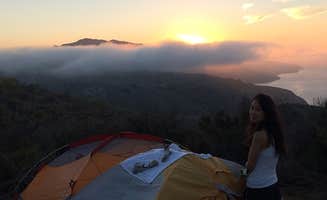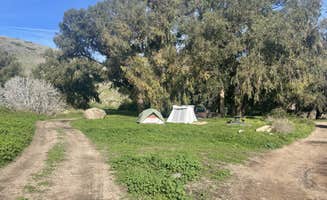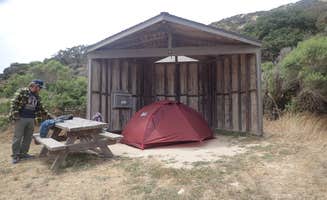Channel Islands National Park consists of five islands located 12-25 miles off the Southern California coast, with elevations ranging from sea level to 2,450 feet at highest points. Temperatures average 55-70°F year-round with strong winds common, particularly on the outer islands. Most tent campers access the islands through the Ventura Harbor ferry, with advance reservations required for both transportation and campsites.
What to do
Wildlife viewing opportunities: Santa Cruz Island Scorpion Canyon Campground offers excellent wildlife viewing, especially for the endemic island fox. "Foxes everywhere. Kayak around and experience seals and dolphins right underneath you in beautiful coves. An amazing and unique experience," notes one camper at Santa Cruz Island Scorpion Canyon Campground.
Hiking trails: The backcountry options at Del Norte provide access to remote areas. "Hiked from Scorpion Harbor cross-island to Del Norte Camp, great way to see the island. Camped at site 1, had the most wind but also the best views of the ocean," according to a visitor at Santa Cruz Island - Del Norte Backcountry.
Coastal exploration: At Anacapa Island, take the short hike to Inspiration Point at sunset. "I highly recommend hiking the short distance to inspiration point at sunset, the views are breathtaking," says a camper who visited Anacapa Island Campground.
What campers like
Disconnecting from technology: The isolation from mainland conveniences creates a unique experience. "What a fantastic getaway! The Channel Islands offer some of the most remote camping, and it's easy to do. Plus, the weather is moderate, and you don't have to worry about wildlife much," shares a visitor at Santa Cruz Island Scorpion Canyon Campground.
Beach accessibility: Santa Rosa Island Backcountry Beach Camping offers direct access to beaches during permitted seasons. "Backcountry beach camping is only open during certain days of the year due to breeding seasons so make sure to check prior to going," advises a camper at Santa Rosa Island Backcountry Beach Camping.
Wildlife encounters: The Channel Islands host unique species found nowhere else. "The island foxes are unruly so watch your belongings, and the fox are cute but sneaky," warns a visitor at Anacapa Island, emphasizing the importance of following storage guidelines.
What you should know
Transportation planning: Access requires ferry bookings through Island Packers from Ventura Harbor. "You have to set up a boat trip here and back so do your homework because it takes some coordinating," explains a camper at Del Norte Backcountry.
Weather preparedness: Strong winds can impact camping comfort and gear stability. "The wind is not a joke. When we came back from hiking more than one tent was blown over. Low profile, use your steaks and we even tied ours to the shelter to keep it stable," advises a visitor at Santa Rosa Island Campground.
Limited resources: Many islands have minimal facilities. "Note, there is no store on the island, we did have spotty cell coverage with AT&T," mentions a camper who visited Santa Cruz Island, highlighting the need to pack all essentials.
Tips for camping with families
Gear transportation: Bring appropriate transport for your supplies from the dock. "You can backpack in if you want to travel light, some folks were wrestling with multiple bags and boxes, but several clever people brought folding wagons to tote things and that was a great idea," recommends a visitor at Anacapa Island Campground.
Water availability: Water access varies significantly between campgrounds. "The campgrounds have clean restrooms and plenty of fresh water so it's perfect for families," notes a camper who stayed at Santa Rosa Island.
Group site options: For larger family gatherings, consider group campsites on the mainland. "We have been camping this site every Spring for about 6 years. We do a family style tent camping. 15-40 ppl. Young kids to elderly adults. Everyone always loves it!" shares a visitor at Danielson Group Multi-Use Area.
Tips from RVers
Alternative mainland options: When looking for the best tent camping near Channel Islands National Park with RV access, mainland options may be necessary. "This is a good group campground with sinks, showers and flush toilets. The one downside is how exposed the campground is, there is no shade. Bring a sun canopy if you can," suggests a visitor at La Jolla Group Campsite, which offers facilities not available on the islands.





